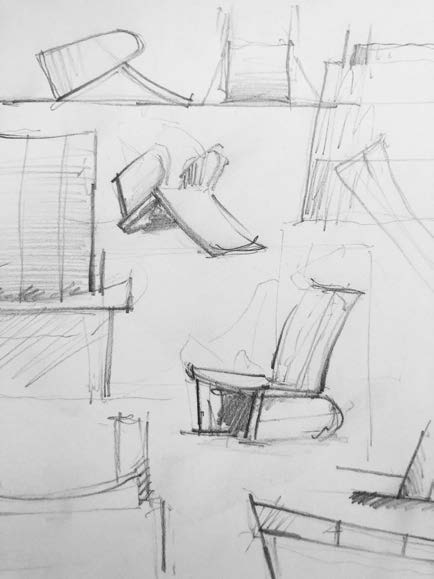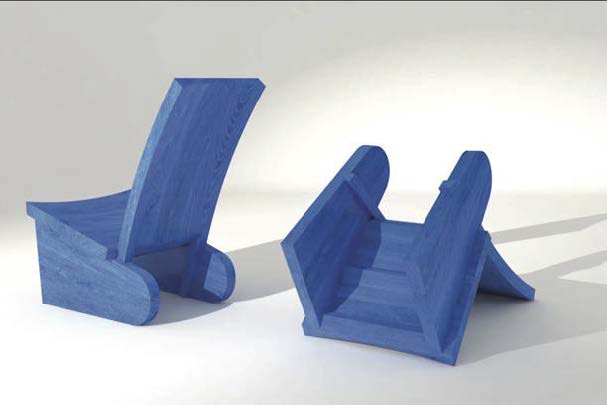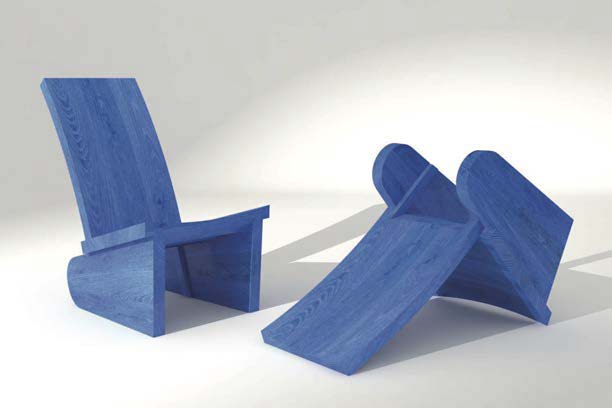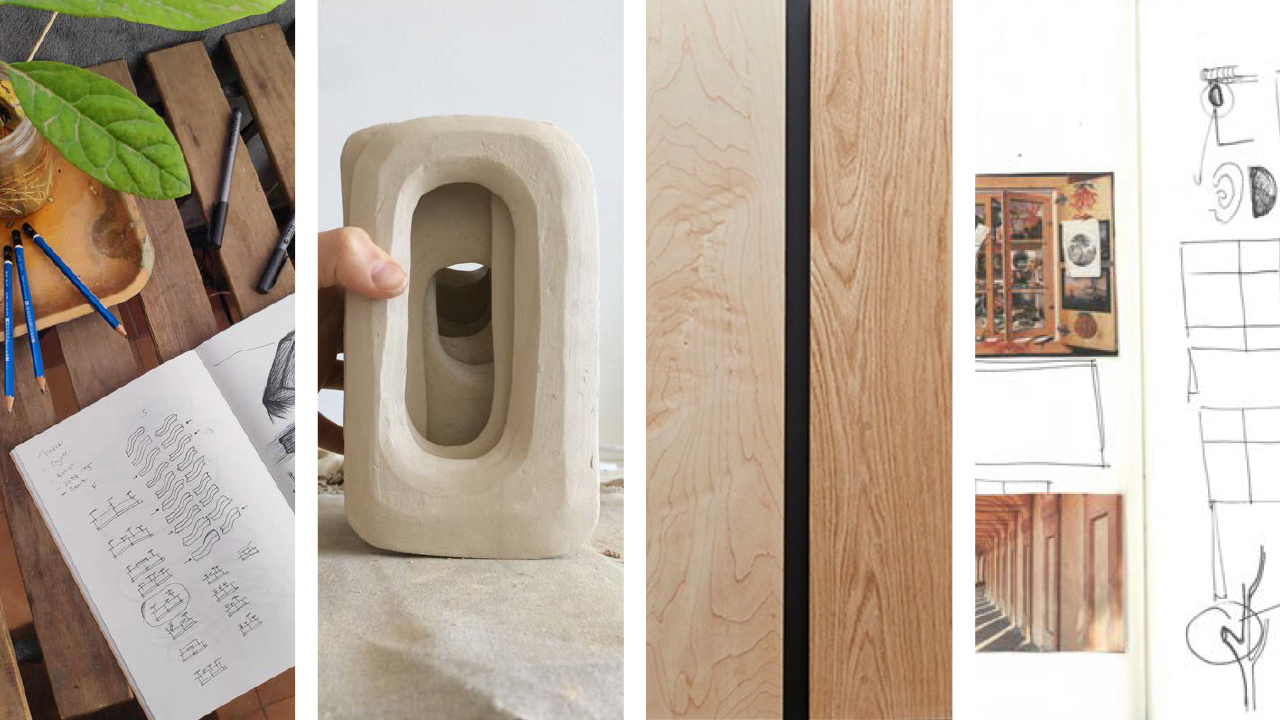Home > Our Projects > AHEC presents Discovered, a platform to foster the next generation of design talent in collaboration with Wallpaper*
AHEC PRESENTS DISCOVERED, A PLATFORM TO FOSTER THE NEXT GENERATION OF DESIGN TALENT IN COLLABORATION WITH WALLPAPER*
American Hardwood Export Council (AHEC) presents Discovered, a new project to support and promote the work of 20 next generation designers from 16 countries, in collaboration with Wallpaper* and in partnership with The Design Museum, London.
Selected from Wallpaper’s annual Graduate Directories and through AHEC’s own network, the designers have worked alongside design mentors and AHEC’s global manufacturing partners to develop a new object made from a choice of three sustainable hardwoods.
Discovered: the designs
With a focus on American red oak, hard and soft maple and cherry, the brief challenged each designer to create an object that responds to their experience of a pandemic world.
Participants were invited to think freely about their experience of living and working in isolation, and to create a piece that represents the functional and emotional connections to our everyday objects.
The designs being created for the project are one-off functional objects and furniture pieces of varying scale, imagined for both domestic, outdoors or public realms. They represent how isolation has inspired the designers’ personal and creative journeys and help rethink the idea of domestic and public space for the future.
Designers were guided by themes of touch, reflection and strength. Through their projects, they explored their own personal and cultural background, or involved their families into the design process. Inspiration came from mundane experiences and everyday life, the desire to connect with nature and the outdoors, and their personal responses represented both a desire for public connection to the affinity for isolation.
The project’s development will be further chronicled through the dedicated discovered.global portal, and promoted through Wallpaper’s own channels. The final pieces will be presented with a display at the Design Museum (London) in 2021.
Throughout the project, designers have been supported and mentored by Wallpaper* editor-in-chief Sarah Douglas, AHEC’s European Director David Venables and AHEC’s Regional Director for Africa, Middle East, India and Oceania, Rod Wiles; as well as a global group of designers including Tomoko Azumi, Maria Jeglinska, Nathan Yong and Adam Markovitz.
Sarah Douglas, Editor-in-Chief of Wallpaper*, says:
‘This is a time when the next generation needs support more than ever, so we are honoured to partner with AHEC in launching Discovered – to ensure the designers of tomorrow have the platform they deserve.’
John Chan, Regional Director for AHEC Southeast Asia and Greater China, says:
‘We are continuing the dialogue about why it is essential more wood is used in product design and why we must expand the range of species we use for the long-term sustainability of our natural forests.
We have turned the spotlight on a new generation of designers from around the world and given them an opportunity to shine.
Drawing on a wide range of disciplines, backgrounds and cultures our 20 talented creatives from 16 countries, give a truly global perspective on what it means to be a young designer today. We are putting at their disposal some of the best hardwoods there are (cherry, hard and soft maple, and red oak), providing mentoring support from established designers and access to top craftsmanship, to give them a unique experience that I really hope will inspire them in their future careers. We are very excited that designers from across our region have been selected to participate as it highlights the incredible creative talent that exists there.
Congratulations to Wallpaper* editor-in-chief Sarah Douglas, AHEC’s European Director David Venables and AHEC’s Regional Director for Africa, Middle East, India and Oceania, Rod Wiles; as well as a group of designers including designers including Tomoko Azumi, Maria Jeglinska, Nathan Yong and Adam Markovitz on the completion of the Discovered project during this most challenge time.
I want to congratulate our 20 designers, the young ambassadors who have been successfully bringing and sharing the message of the sustainable and, beautiful US hardwood from USA to the world for Interior and Furniture Design.
Working with The Design Museum in London, and joining forces with Wallpaper* will make this an unforgettable collaboration’
Meet the designers and their projects
Doris Wang
Winding Stream
Wood: American hard maple
Unable to perform habitual traditions during lockdown, people are confined to perform rituals at home. There is a novel need for suitable furniture and objects that can fit a small space but serve the same purpose. Wang wanted to create a domestic alternative to the ‘winding stream party’, a Chinese drinking custom usually performed at tea houses: a cup is floated down a stream with people sat on both sides; the person sitting in front of the cup that stops has to drink it. Designing a compact table that could perform this function, Wang was inspired by Hakka round houses, an architectural reference which she translated into a sinuous table design with storage concealed in the legs and a central slit to fit trays and cups.
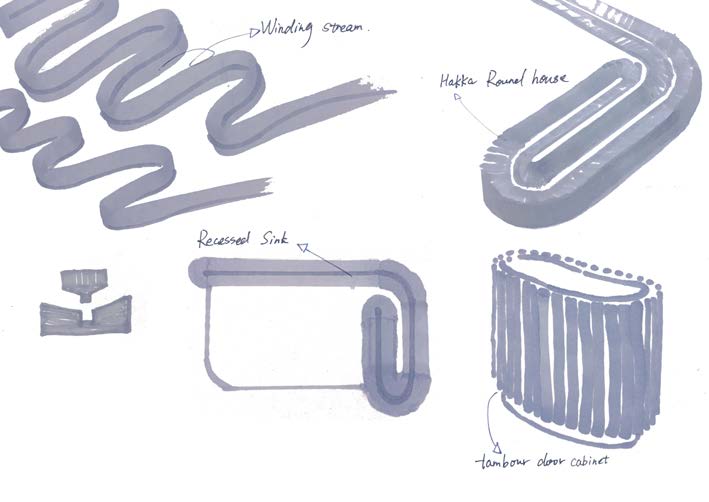
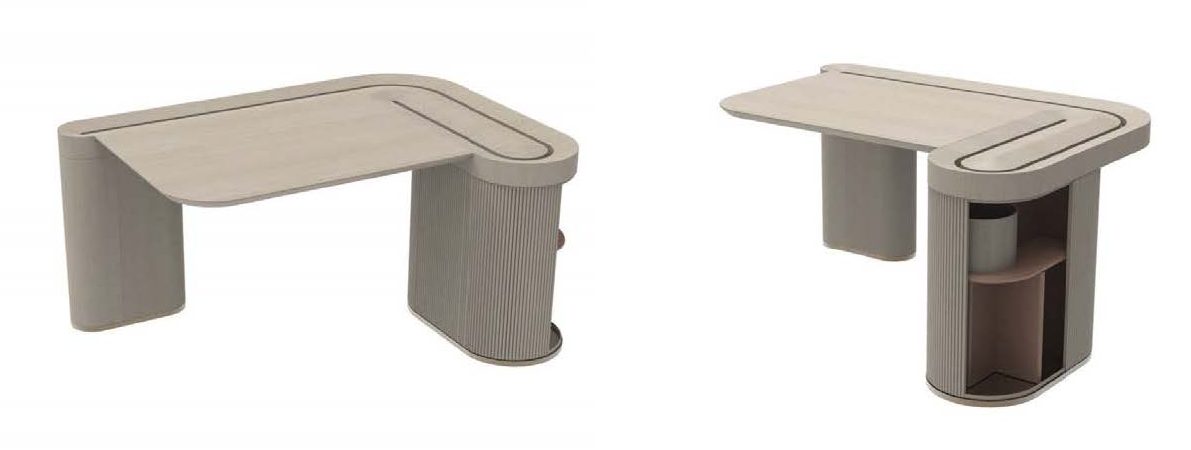
Tan Wei Xiang
Recollect Cabinet
Woods: American soft maple, hard maple, red oak
Searching for a tangible physical connection to loved ones (beyond virtual calls), Tan resorted to keepsakes as a way to fight nostalgia. His keepsakes cabinet is imagined as a way to hold, preserve and give respect to the items we hold dear, and its forms were inspired by Singapore’s ubiquitous construction sites and the ridged zinc sheets used to protect them from the outside. Tan recreated this motif as the outer shell of his tall, lean cabinet, and created curved shelves to sit inside it with a mirrored, high polished brass circle, mimicking the sun setting on the horizon.
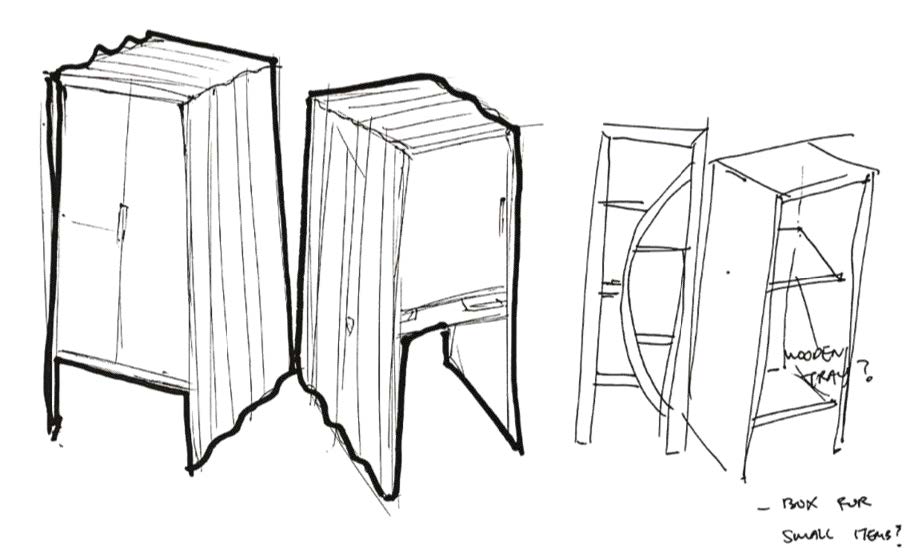
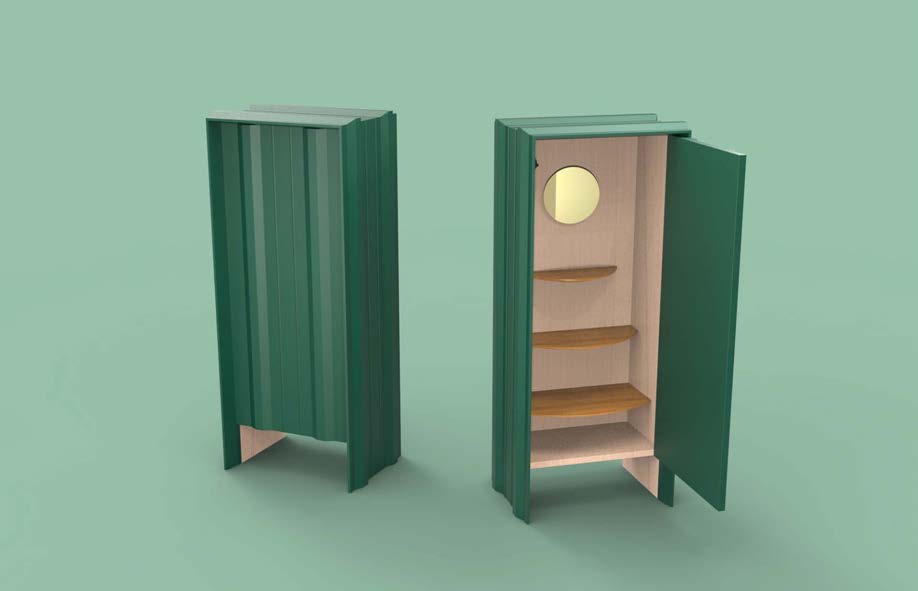
Huyen Trang Thi Nguyen
The Roof Stool
Woods: American cherry, red oak, hard maple
Nguyen looked at traditional Vietnamese roof tiles for her project, creating a collection of nesting stools that replicate the way the tiles overlap to hide the connecting structures below. Her simple stool design is inspired by traditional temple architecture and Vietnamese dresses, and features pins made of contrasting wood at the joint, which remains hidden when the stools are stacked and is revealed when in use. Nguyen observed how people tend to spend more time at home and hosting friends, so her design is imagined to provide a series of extra seats around the house, while creating a beautiful composition while not in use.
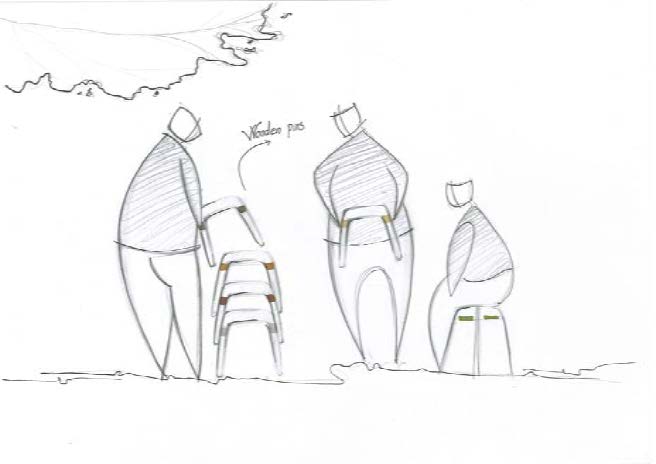
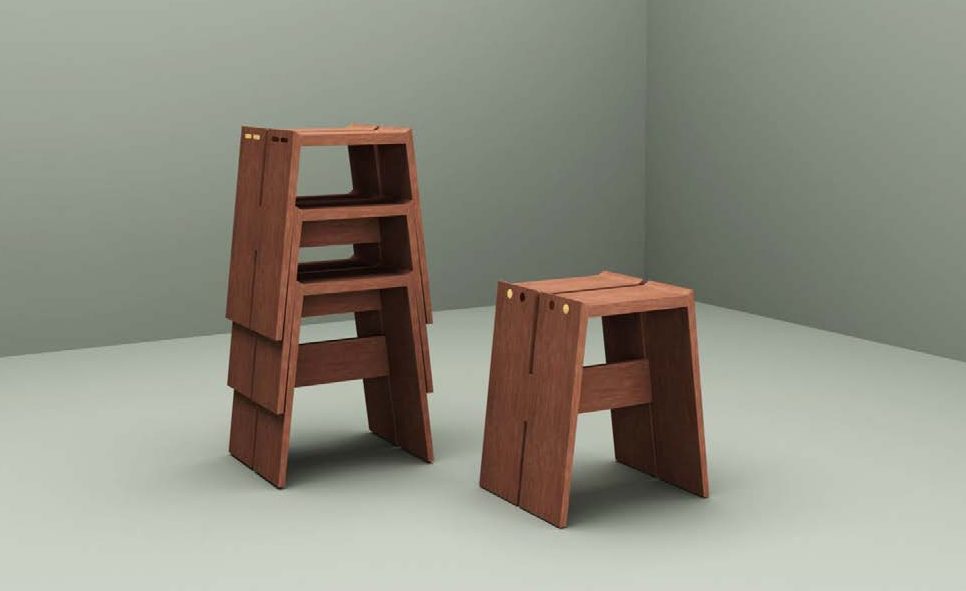
Nong Chotipatoomwan
Thought Bubble
Wood: American red oak
A nostalgia for traveling and social interaction guided Chotipatoomwan’s creative thinking through her project. Physical transitions were replaced with changing states of mind, and the physical realm merged with the psychological realm through domestic space. The designer looked at furniture created for relaxation, and landed on a rocking motion, which became the basis for her rocking chair, offering a mix of relaxation and repetitive movement to enhance mindfulness.
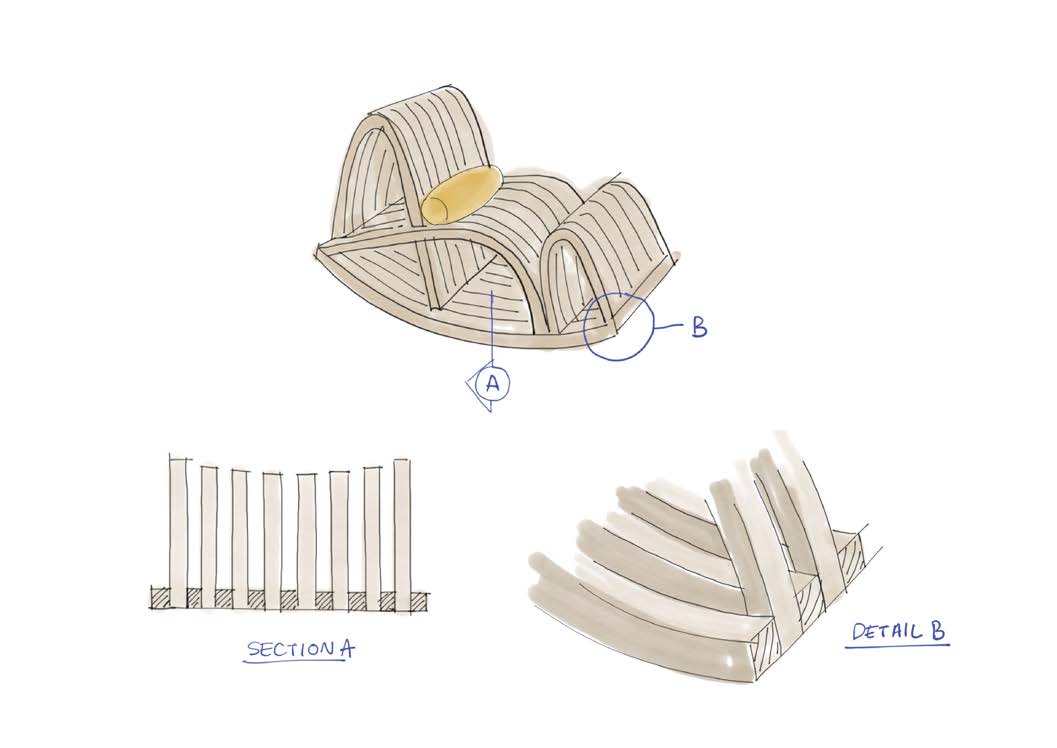
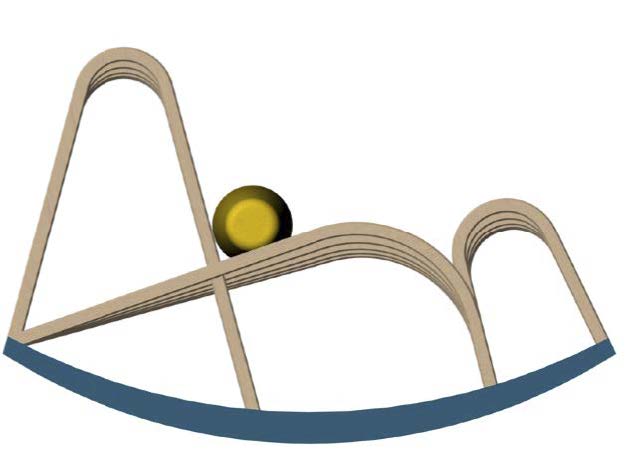
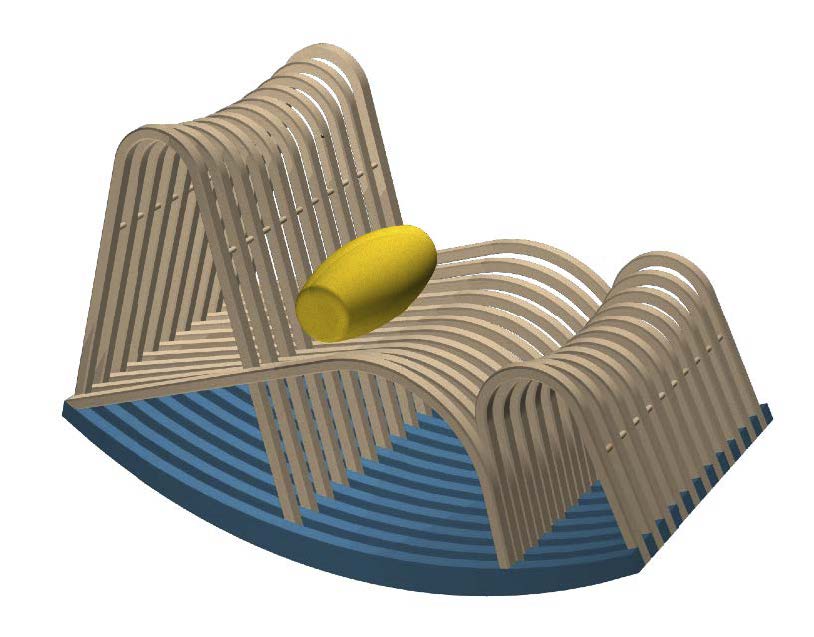
Mew Mungnatee
Corners Lamp
Woods: American soft maple and cherry
Mungnatee’s design was inspired by pagodas, whose intricate surfaces were produced by hand by highly skilled Thai artisans using a 200-year-old technique. The designer’s emotional response to the objects surrounding her manifested in the relationship between form, light and shadow, and through this project, she explored this connection through geometry. Her lamp designs are based on a bulb casting a shadow over the below surfaces thanks to an intricate grid composition featuring wooden slats and indented corners.
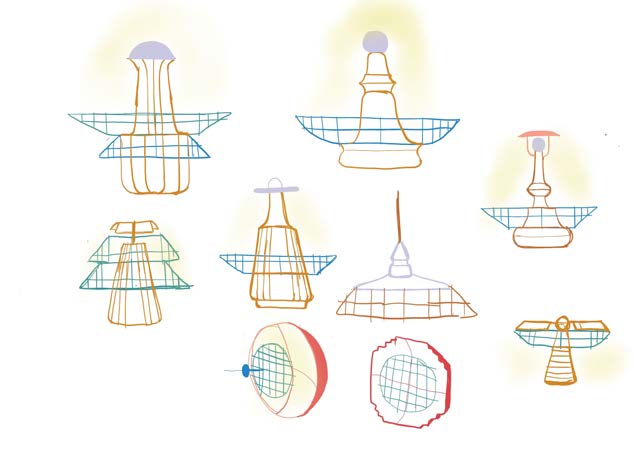
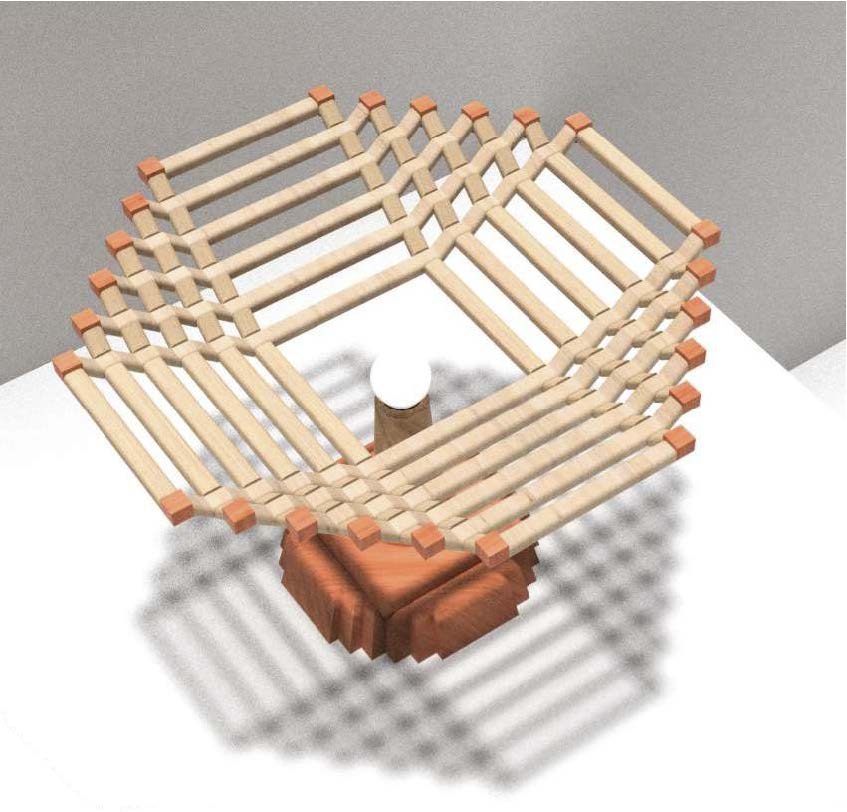
Duncan Young
Akin
Wood: American hard maple
Young focused on the materiality of timber, and how this organic material can help us connect with nature while confined at home. ‘For those in dense urban environments, [lockdowns have] impacted our physical and mental strength by limiting the biological need humans have for being in outdoor spaces,’ he says. He looked at studies analysing the positive impact of nature on physical and mental health, and as a result he created a modern cabinet of curiosities as a pillar to nature, for the user to engage with the natural world while at home. Featuring a solid carcass with discreet joinery and a moiré effect shelf (a design inspired by historic symbolism of the cabinet as a theatre), the simple plinth celebrates the material by recreating the effect of walking into a glade.
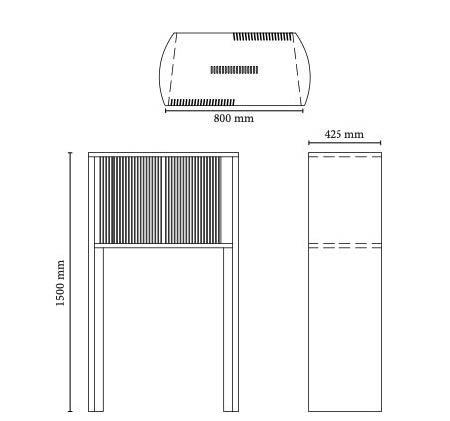
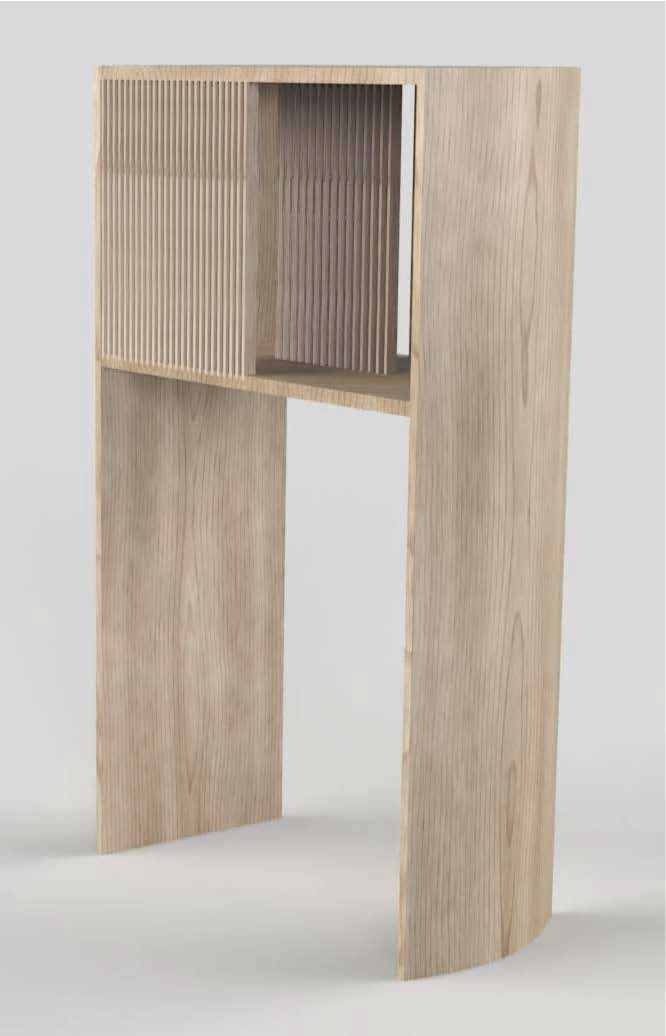
Vivienne Wong
luxta Me Coffee Table
Wood: American cherry
Dancer turned designer Wong looked at non-verbal communication as the starting point of her project, approaching the task from a personal point of reflection and knowledge. ‘I wanted to translate my previous understanding of how we can connect and communicate to one another,’ she says, looking to create a piece to nurture strength, intimacy and connection. Invisible physical boundaries and the creation of textures through light formed the basis of the project, which developed into a coffee table featuring interlocking echoed forms, where the functional joinery also becomes a decorative motif for the piece. Her design’s name, Iuxta Me (meaning ‘near me’ in Latin), represents the desire for human connection and closeness that guided the process.
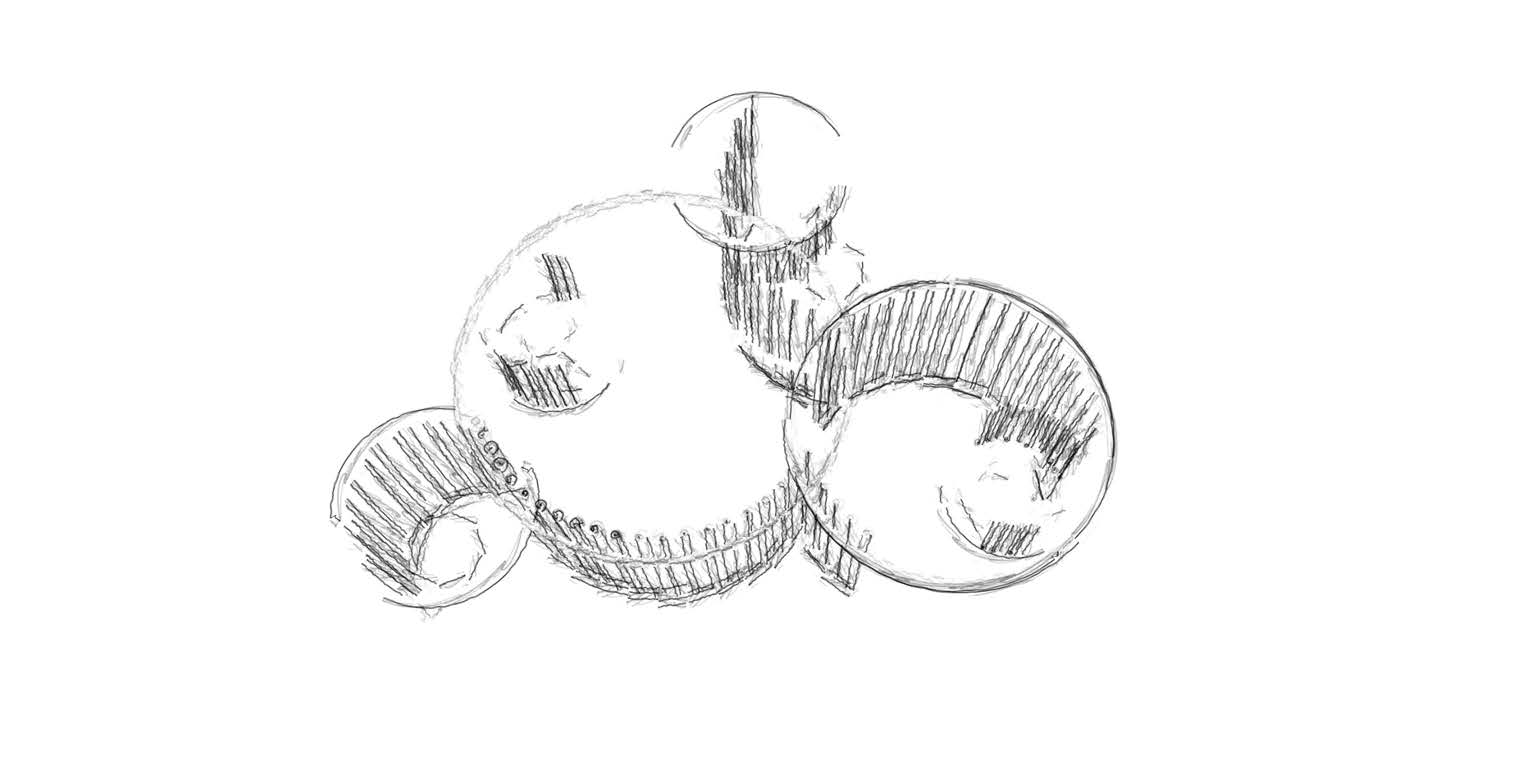
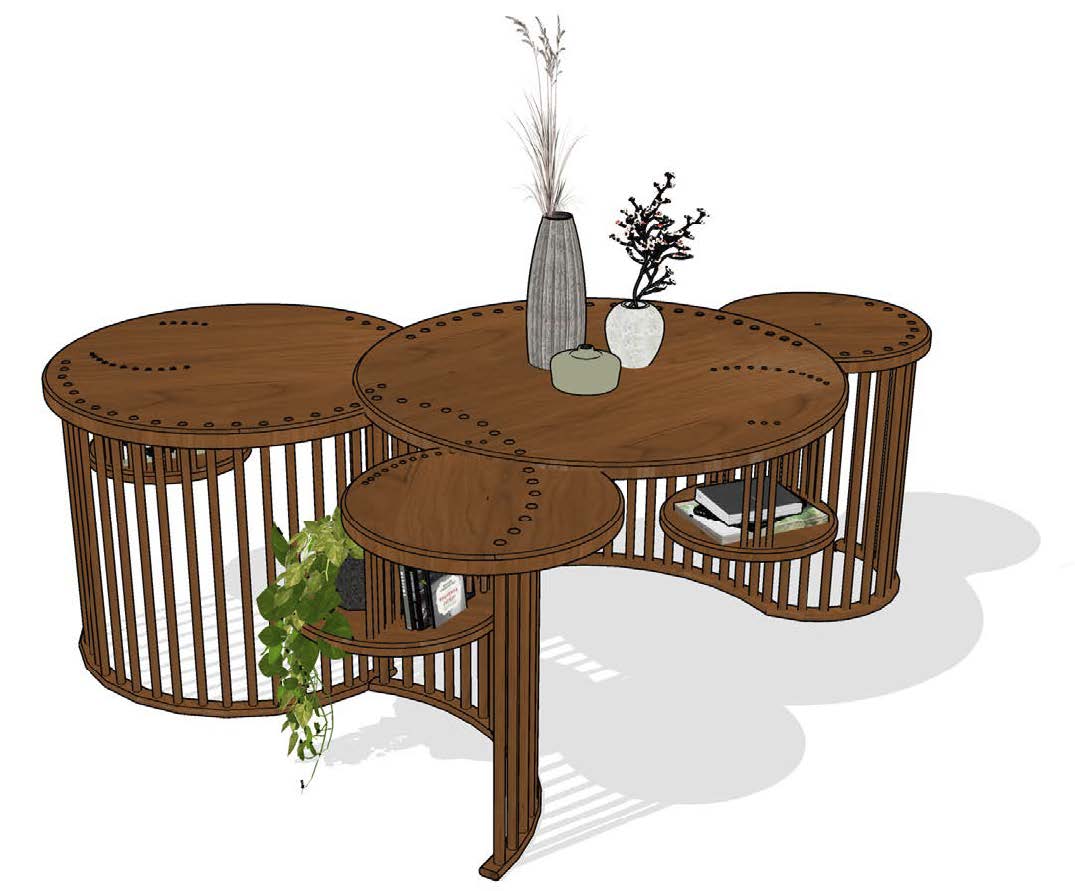
Sizar Alexis
Lahmu
Wood: American cherry
Having lived through the Iraqi war in the 1980s, Alexis imagined his home as a bunker, protecting his family and newborn son during the pandemic. Drawn to the similarities between his own childhood experience and his young son’s, his sculptural pieces are defined by starck monolithic forms and stillness. The chunky volumes of the designs serve as a storage cabinet and a bench, and were inspired by bunker architecture.
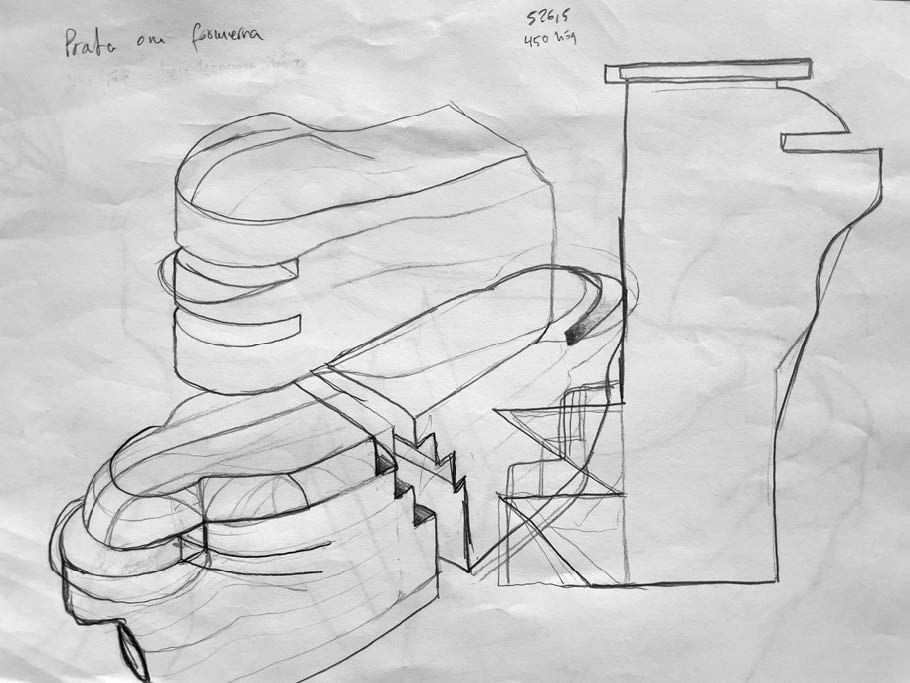
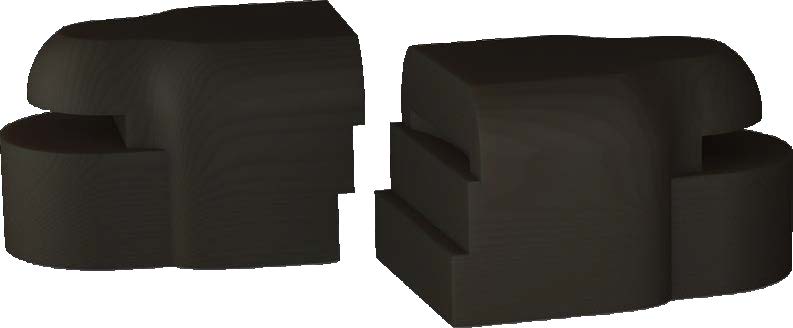
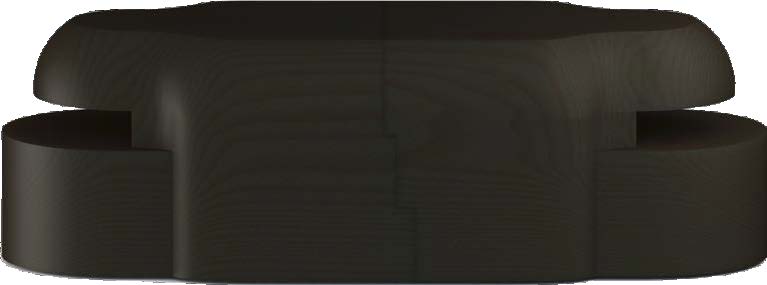
Isabelle Baudraz
Presences
Wood: American cherry
Fighting a feeling of isolation, Baudraz recreated tactile and emotional connections through her trio of objects. Inspired by the idea of bringing natural movements and forms into the home, she created a series of objects that encourage touch and interaction. Her collection includes a suspended mobile, a balanced object imagined to stand on a desk and a wall-mounted installation to create moments of tactile connection during days in isolation. Inspired by natural shapes, the modular pieces are small everyday companions to reconnect with life and beat the feeling of isolation.

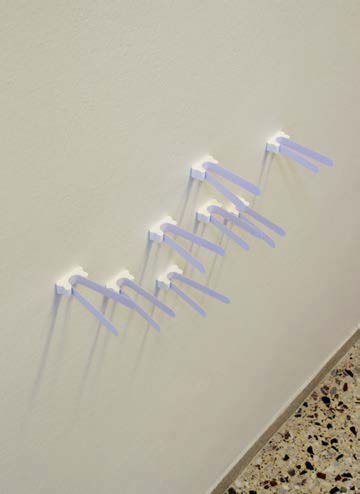
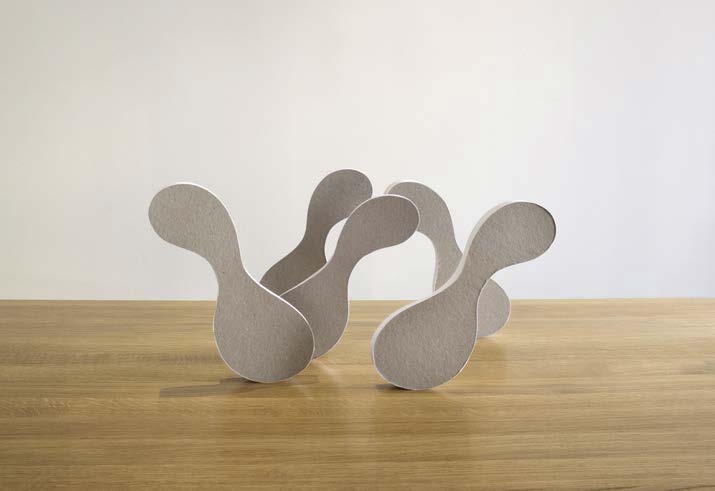
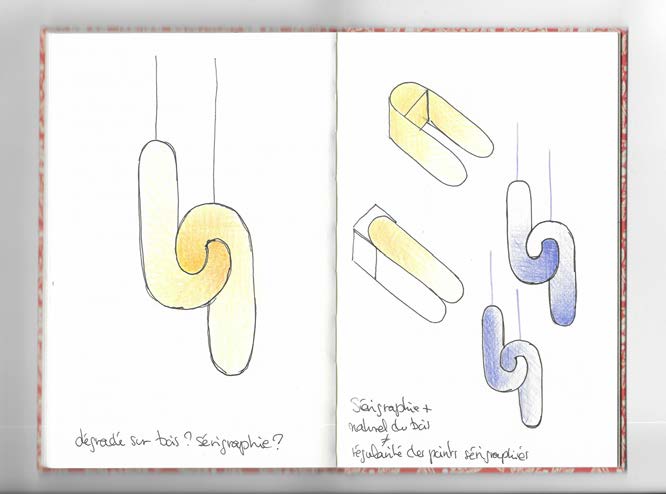
Mac Collins
Concur
Woods: American red oak
While the term ‘isolation’ seemed to have acquired negative meaning over the course of the past year, for Collins the word carries positive meanings. ‘For me, the word has always carried romanticized connotations of contentment, serenity, contemplation, and a sense of withdrawal from the rigmarole of socially prescribed routine,’ he says. During his time alone, books became precious companions, and this inspired him to create a place for reflection and reading. His immersive double-armrest lounge chair (and a bookrest ‘companion object’) encourages the sitter to tune out of daily life and focus on an analogue task.
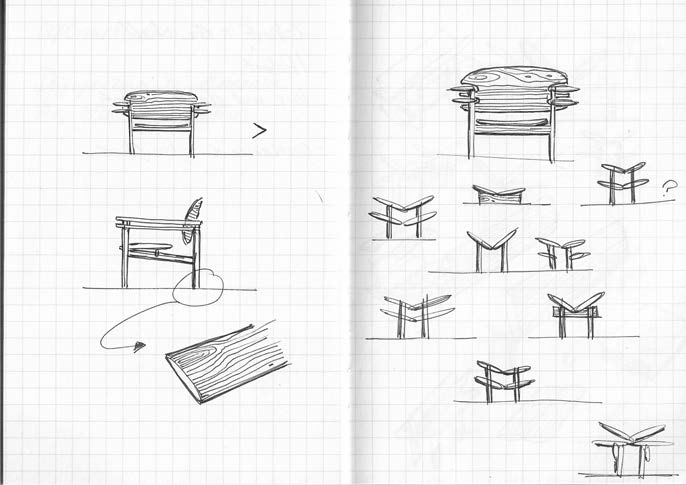
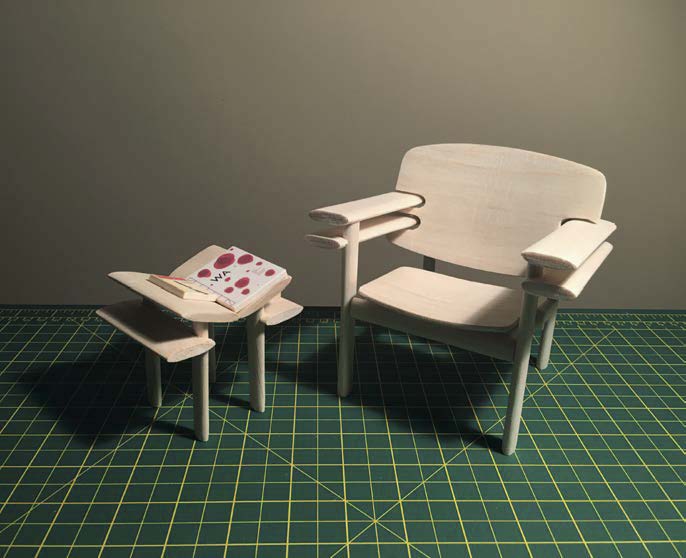
Siyanda Mazibuko
Kumsuka – evolve your space
Wood: American red oak
The inspirations for Mazibuko’s piece included Isicolo, a hairstyle symbolising tribal identity in several African cultures, and Indlamu, a Tribal Zulu dance practiced in celebratory ceremonies. He paired these visual references with a reflection on themes of engaging, human behaviour, and the role of design in people’s lives. ‘Engaging with other people is an intrinsic human trait,’ he says, citing this as the reason for his design, a modular, layered seat imagined for public spaces. He took a practical approach, looking into ergonomics and function to create his bench, composed of interlocking strips of timber.
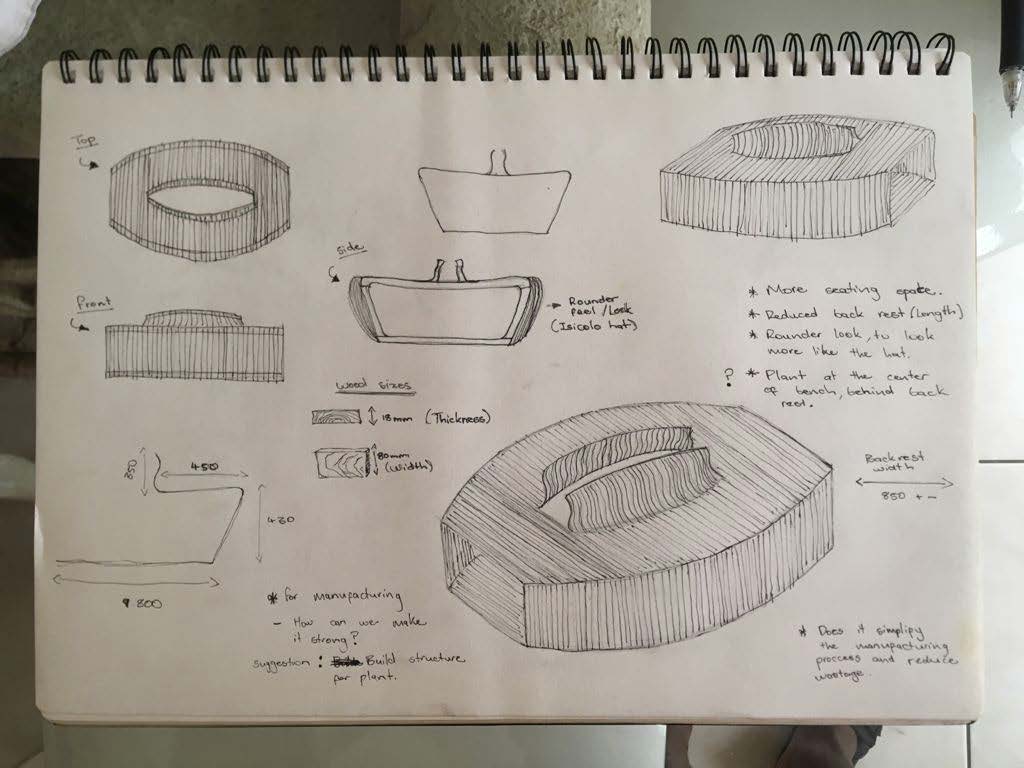
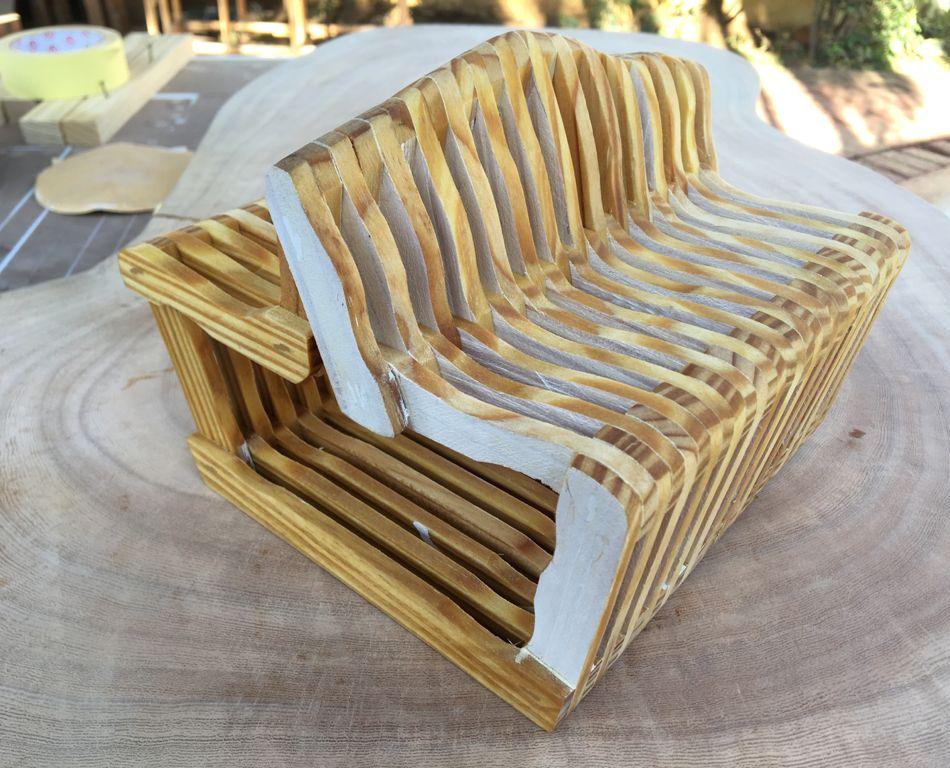
Josh Krute
Toteemi
Wood: American hard maple
Inspired by totems (Toteemi meaning ‘totem’ in Finnish), Krute created a multifunctional storage system. As domestic spaces get taken over by work materials during time at home, Krute imagined a series of stackable boxes to stow work supplies and small objects, while other components serve as a side table, tray or stools. The modular system looks at tactile wooden objects, birdhouses and small structures, which Krute streamlined into a compact, practical design. ‘Toteemi provides solutions for how we delve between living and working in the same environment,’ he says.

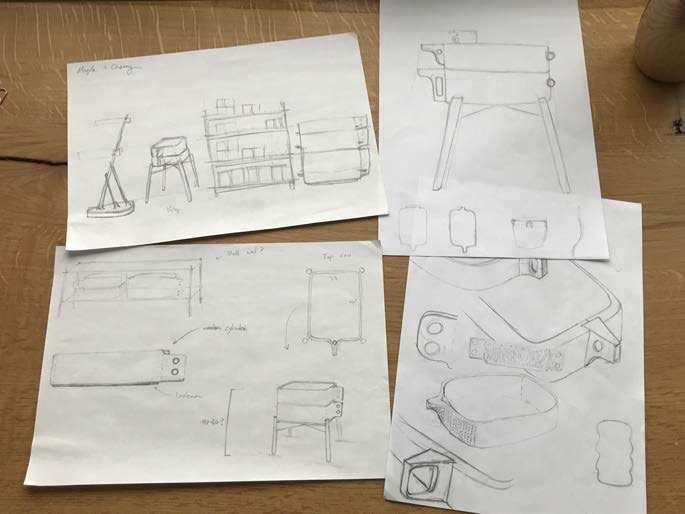
Kodai Iwamoto
Pari Pari
Wood: American red oak
Iwamoto’s research for his project included traditional Japanese techniques such as Uzukuri (giving texture to wood by scrubbing), Chouna (chiselling the surface with an adze) and Wariita (peeling the wood with a Japanese Froe). From there, the designer started experimenting directly on the wood, peeling its layers to then create a new veneer. These imperfectly textured panels became the starting point for a design exploration that landed him on a round table shape, featuring the subtle material as the base to create the effect of an ancient tree trunk.
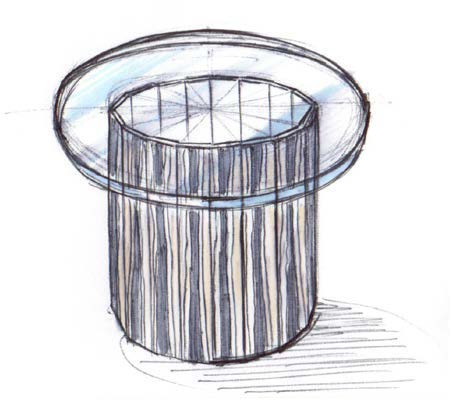
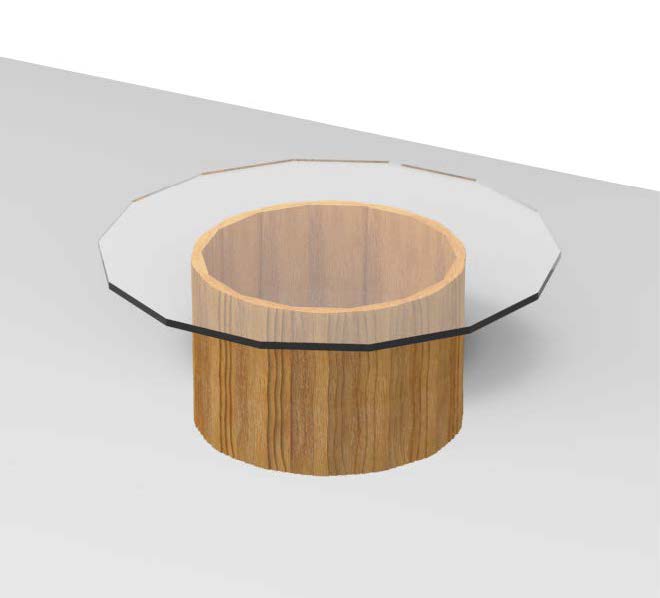
Pascal Hien
Migo 01
Wood: American red oak
‘The pandemic has been a time of pause and reflection, when we became more present with ourselves and our surrounding,’ observes Hien. His object, a multifunctional stool, is the result of the designer’s reflections during a time of change and uncertainty, learning to adapt and tune out of his fast-paced life. The stool represents this ever-changing life: ‘you can adapt to it in various ways, there is no front and back, no right or wrong.’ It becomes a helper around the house or a place to sit. While living with his family during the pandemic, Hien involved them in the testing of the piece, for the first time making them a part of his design work.
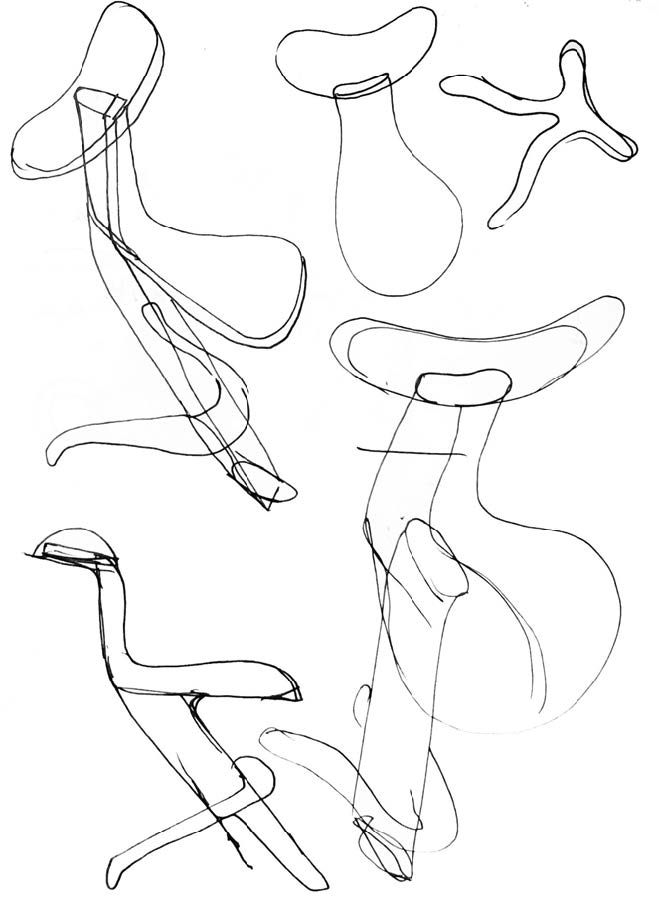
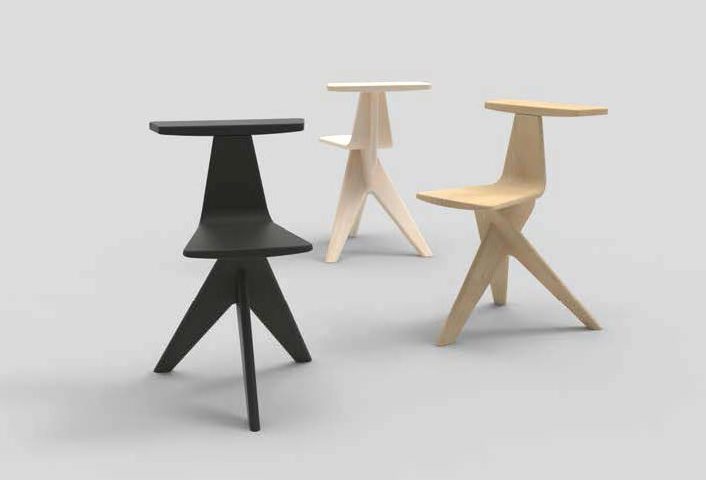
Alessandra Fumagalli Romario
Studiolo 2.0
Wood: American cherry
During extensive Zooming, video meetings and Insta-lives, Fumagalli Romario observed people’s curated backgrounds, which got her thinking about ‘the importance of objects as extension of ourselves: from one side, many boundaries are created, from another, boundaries disappear, private and public are mixed together.’ She likened this curated space to the small studioli found in Renaissance paintings, and to cabinets of curiosities. Inspired by this, she created a visual background, a cabinet to present oneself through objects that could be exhibited or hidden. Using cherry to convey depth, her design is a compact architecture that has both practical and aesthetic purpose.
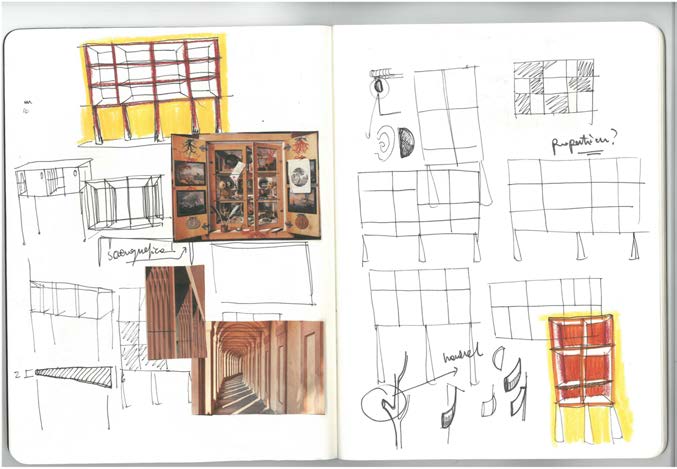
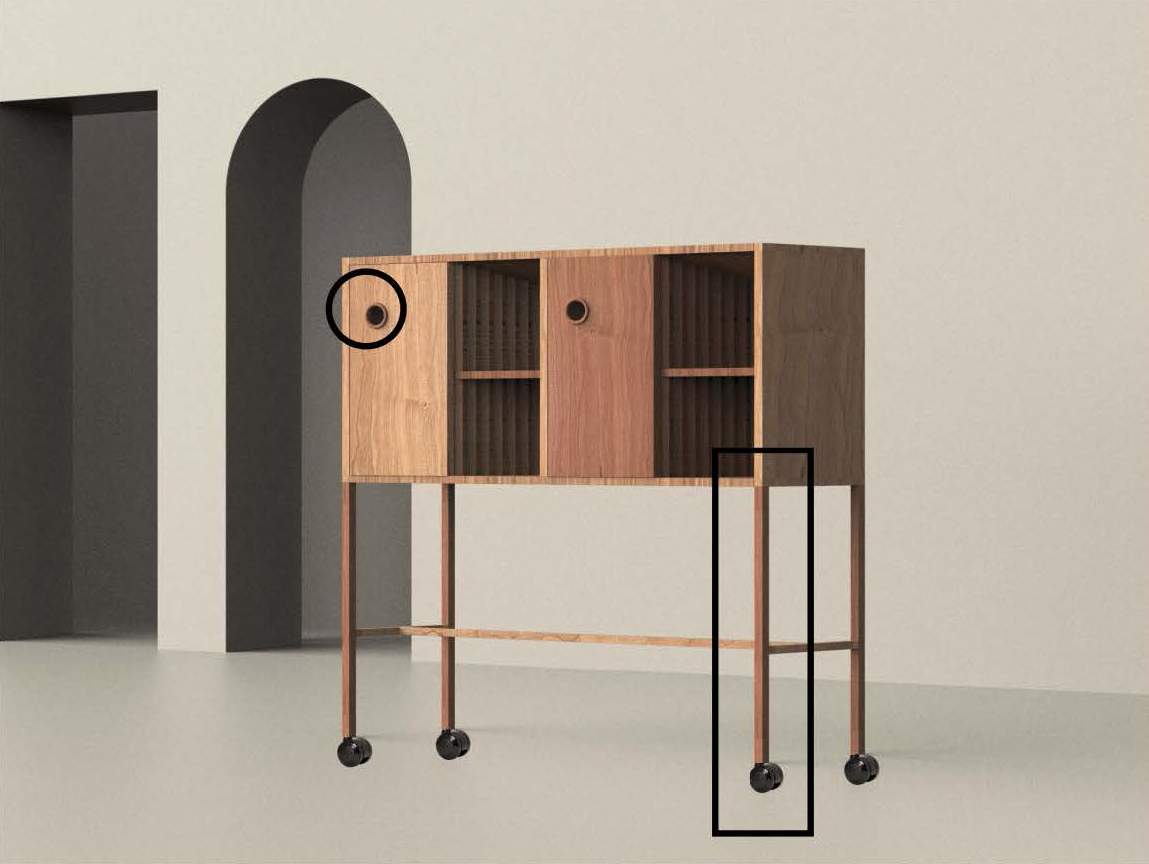
Taiho Shin|
Ikare
Wood: American maple
During his time in isolation, Shin noted that ‘objects help human resilience through unusual situations,’ and this thought served as the basis for his project. Guided by the ‘Ikea effect’ (consumers place higher value on products they partially created), he thought of a half-made design that users could partly assemble to foster interaction with their objects. He created one small table, put together thanks to an ingenious but simple to use joint system (and no glue necessary), and the design multiplies to create a stackable system of shelves, a flexible system suitable to different spaces.
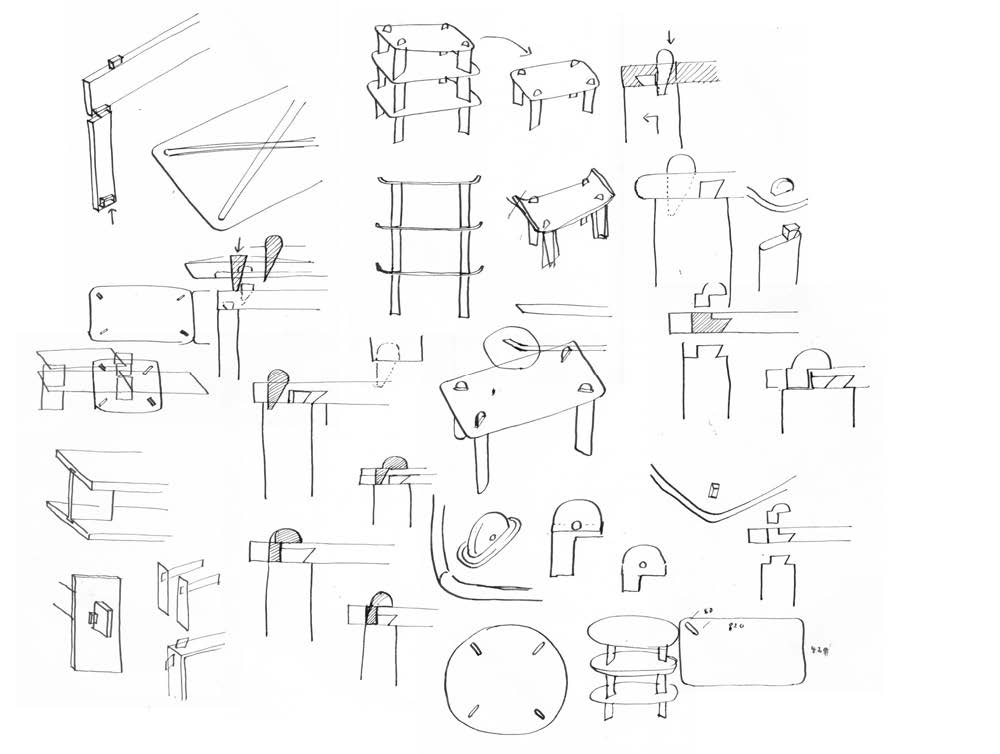
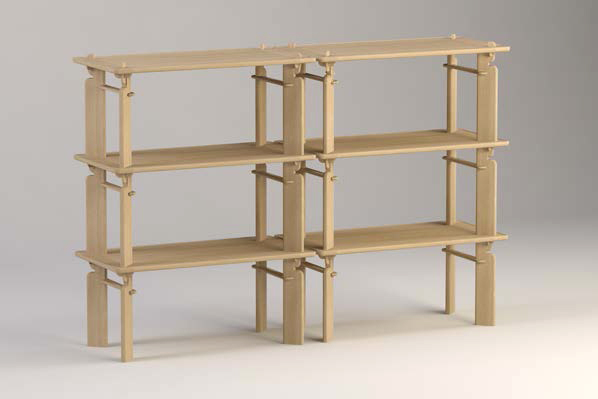
Mimi Shodeinde
Howard desk
Woods: American red oak, soft maple
The pandemic world is all about newness, observes Shodeinde: new dangers, new ways of interacting, living and working. ‘In designing furniture for this new paradigm,’ she says, ‘we should lean into the familiar, the comforting, we should seek freedom, connection, stability and strength.’ These qualities are to be found in her design: a solid desk whose light forms contrasts with the rigorous construction and the weight of the wood. The designer looked at a vast pool of cultural references, from the compositions of British sculptor Barbara Hepworth to the modernist architectures of Lina Bo Bardi, and the aerodynamics of flight (pilot Howard Hughes inspired the name of the piece): these influences converged into a sinuous silhouette, a design that challenges the familiar but also offers a sense of safety.
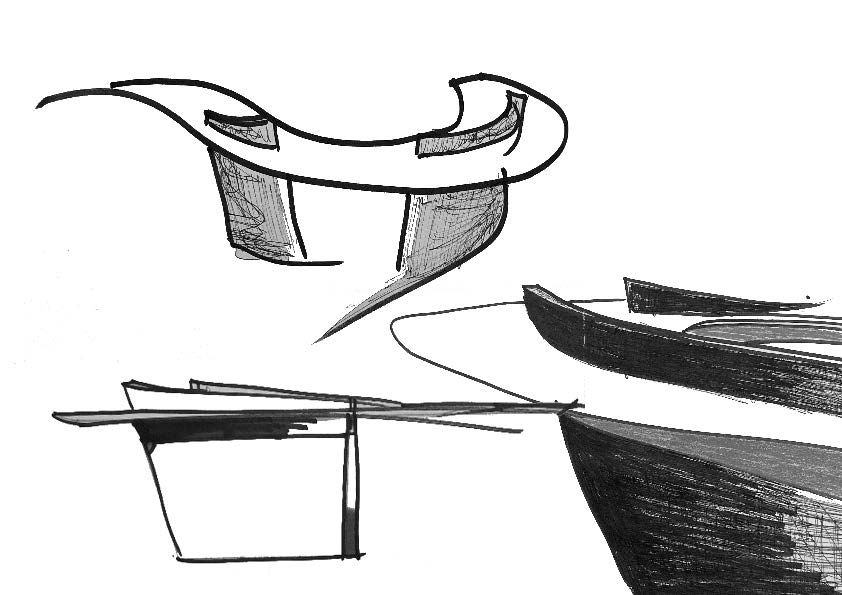
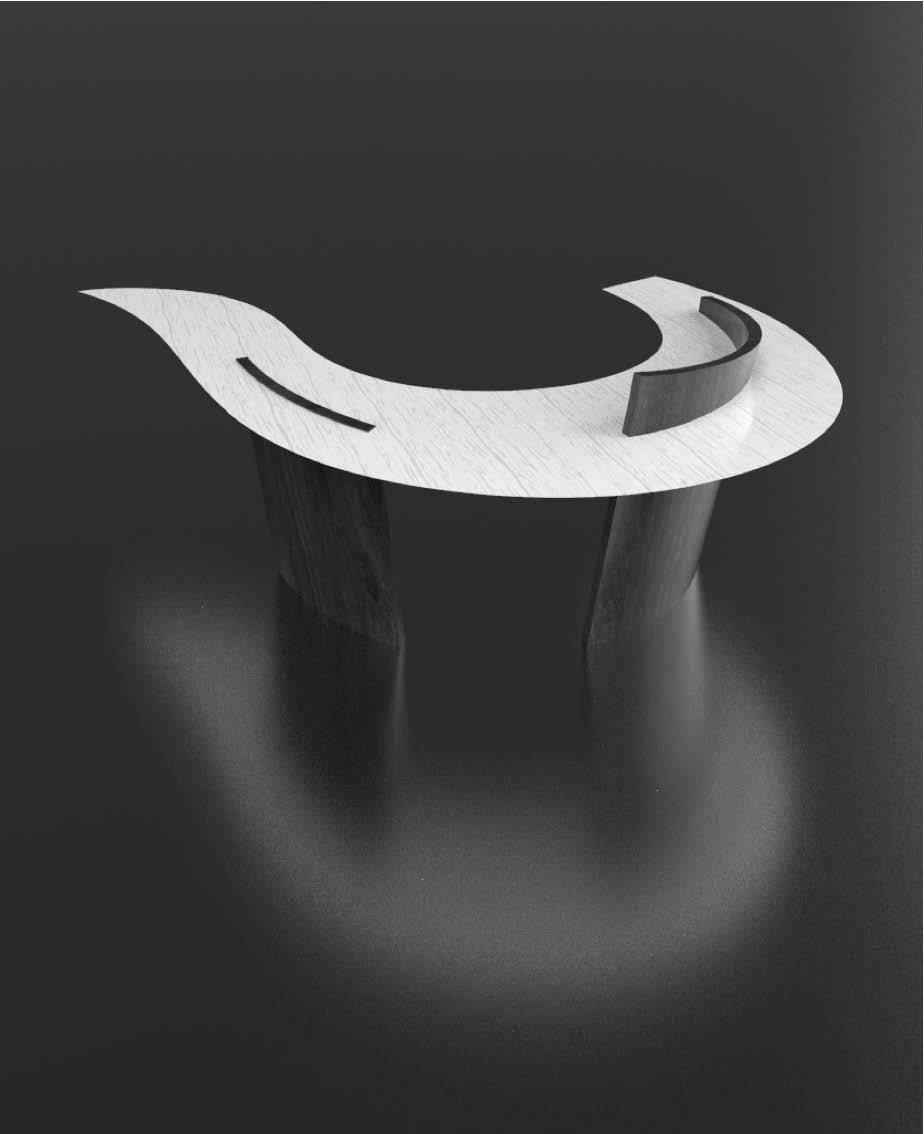
Juan Franco and Juan Sierra
Riverside bench
Wood: American red oak
During isolation, objects change their function and their meaning, and we find ourselves looking for space within our space. This was the observation that kicked off Franco and Sierra’s project, who looked at how our furniture changes function and how adaptability is key (in a pandemic as much as in modern living). Inspired by adaptable design (such as Colombia’s pile dwelling houses), they created a bench that suits different needs thanks to the addition of accessories such as backrests and trays that clot into a central fissure. This way, the bench becomes a multifunctional space that can adapt to home, workspace or public environment.
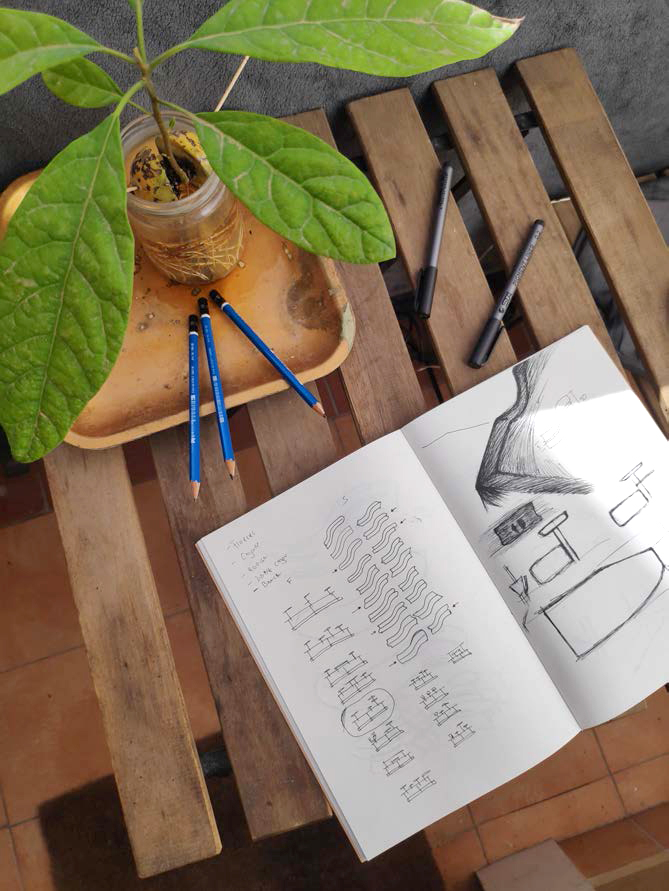
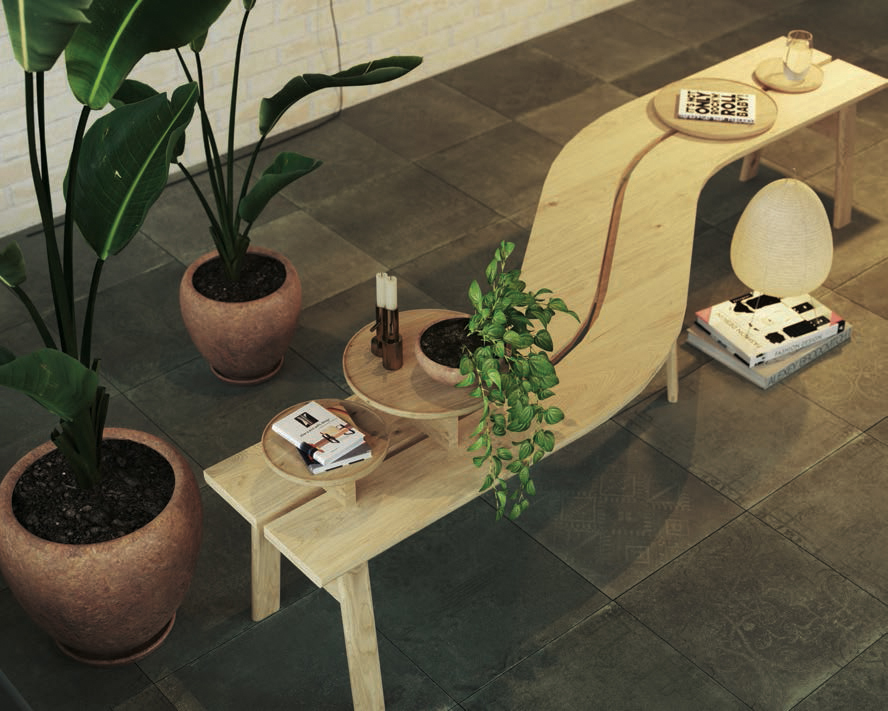
Ivana Taylor
Reframe
Woods: American maple, cherry and red oak
Taylor’s own experience of solitude led to extensive periods of reflection, ultimately inspiring the designer to change her approach to designing and making. For this project, she aimed to design a contemplative sculptural object that triggered reflection on the multi-layered nature of any experience, including isolation.’ A recurring theme of her research featured ways of framing the view at different scales, and the resulting design is a sculpture made from a series of small carved objects that layer to create a composition acting as a ‘sculpted path for light’.
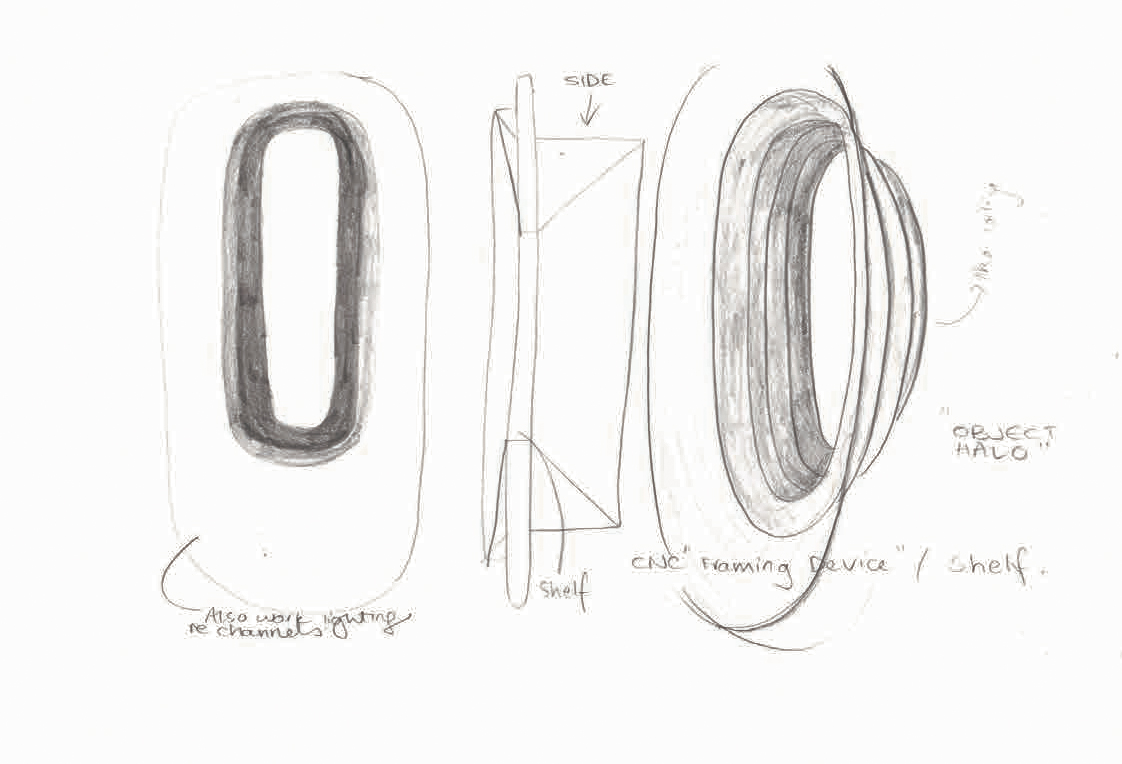
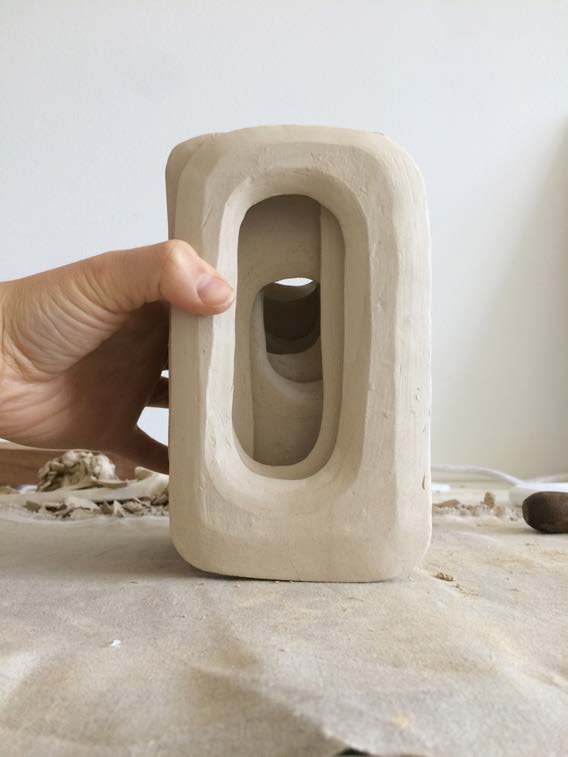
Martin Thübeck
Rå
Wood: American red oak
While confined at home with his young children, Thübeck found inspiration in the way they innately adapted their surroundings for play, challenging traditional ways to use furniture: ‘limitations became possibilities’, he commented. After looking at traditional furniture and playground equipment, he developed a piece whose construction is informed by traditional Swedish craftsmanship traditions, and whose function can be interpreted both as a chair or a slide by flipping it upside down. ‘This piece is a symbol of coexistence, and the act of turning it is like moving between worlds,’ he says, citing a combination of approaches that merges indoor and outdoors, static and movement, adults and kids’ points of view. ‘My intention is not to fully merge the two functions, but to see what happens when they are so close to each other that they become one,’ he says.
